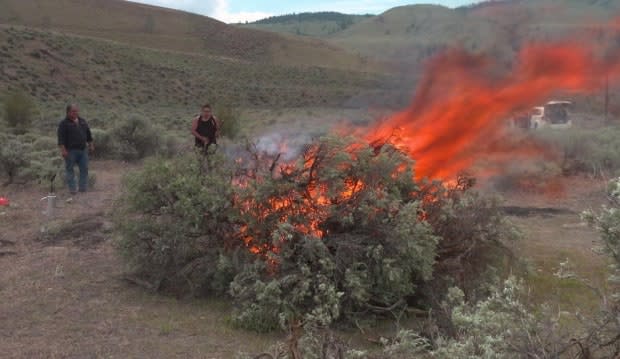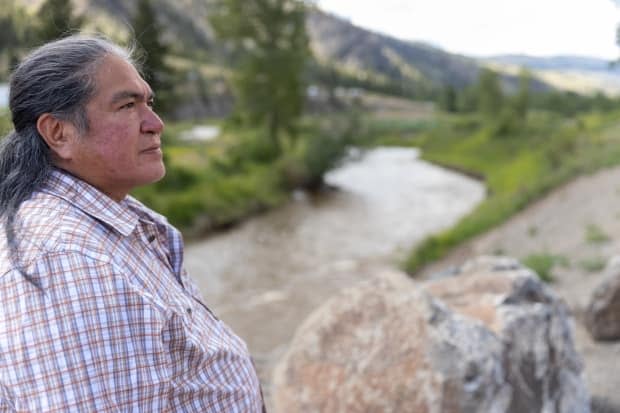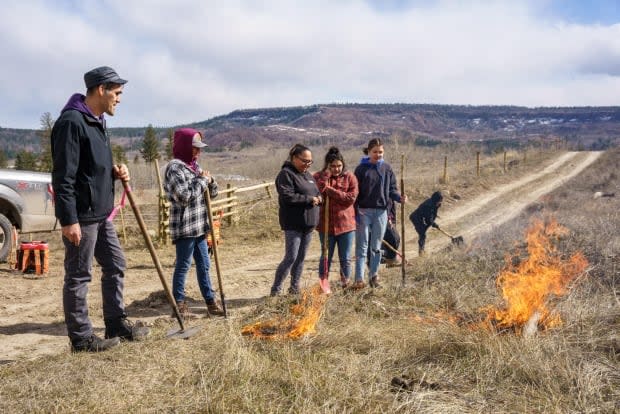Indigenous fire keepers and ecologists say it's time to light a careful fire to calm wildfires

With a deft swing of a drip torch, Joe Gilchrist ignited sagebrush near Savona this spring, just northwest of Kamloops. B.C.
In seconds, an angry crackle grows into a tongue of orange flame, fluorescent against the dusty landscape of the Skeetchestn Indian Reserve in central B.C.
Gilchrist — a fire keeper — sets fires to fight wildfires and "cleanse" the land.
He is one of about 20 members of the growing Interior Salish Firekeepers Society and part of a growing movement. Indigenous knowledge keepers and fire ecologists are reigniting an ancient practice outlawed during colonialization when he says at least one fire keeper was hanged for setting fires.

This June, British Columbia earmarked $359 million for future wildfire protection, with $1.2 million invested in burn projects this year. The province says it supports cultural burning which is prescribed by the Declaration on the Rights of Indigenous Peoples Act Action Plan (UNDRIP).
But fire ecologists say that support is falling short and plans to burn often fizzle out because of approval delays.
In B.C., hundreds of thousands of hectares used to be deliberately burned each year, but now fewer than 10,000 hectares of land is set on fire for community protection.
In the past two years, the Ministry of Forests says burn projects have doubled — rising from 33 to 69 between 2021 and 2022. This year, a total of 9,100 hectares of planning burning was tracked, but not all of it was burned due to weather or safety issues.
Worst wildfire seasons in B.C. by area burned, in sq. km.
The ministry says it's supportive of Indigenous-led burning, which is eligible for funding under the Community Resiliency Initiative program, and the province has worked with First Nations in the Fraser Canyon, the Okanagan, the Kootenays, the Cariboo and Chilcotin and the Pemberton Valley.
Minister of Forests Katrine Conroy said in a statement: "Last year's devastating fire season highlighted the importance of wildfire prevention for B.C. communities and, as we saw first-hand in places like Logan Lake, how it can make a real difference for people's lives."
Earlier in June, Conroy said the province earmarked $25 million for the Forest Enhancement Society of B.C. for programs to reduce wildfire risk, including prescribed and cultural burning.
But fire keepers say that support is too limited.
"Commitment has been really minimal, but I think that it's growing," said Gilchrist.
Fire keepers and ecologists say more needs to be done, and fast, with the province experiencing the biggest wildfire season ever recorded in 2018 — after more than a million hectares burned.
WATCH | The growing movement to reclaim traditional practices:
Use fire to fight fire
A record-breaking heat dome in 2021 made things worse. A year ago, temperatures soared to 49.6 degrees C in the town of Lytton B.C., before wildfire incinerated the community, killing two residents.
Scientists who study fire say it's time Canada learns from other fire-ravaged places on the planet that are aggressively using fire to fight fire.

Cultural or Indigenous burning to mitigate wildfires is seeing a resurgence from California to Australia as the climate crisis makes summers hotter and drier, upping the ferocity of wildfires.
Gilchrist says setting controlled fires helps reduce fuel for wildfires where the land is so dry little rots.
"If it's not burned it just piles up," he said.
"It just takes a lightning strike or human accident for a catastrophic fire."
Wildfire burn area by hectare in B.C. since 1970
Controlled fires help calm wildfires
The baritone-voiced "elder in training" warns visitors to watch for baby rattlesnakes in the tall grass that's sprouted in the two months after this swath of land was burned in April. It creates a green buffer slowing any wildfire.
"The Indigenous use of fire needs to be legalized. Under-burning in the forest isn't bad. We're not trying to kill trees. We are just trying to bring back the medicine and the forage and to make the communities safe because there's going to be a lot less fire," said Gilchrist.

Chilliwack wildfire ecologist Robert Gray says cultural burning dates back "hundreds of thousands of years" and enabled Indigenous communities to evolve and thrive.
Traditionally, Indigenous fire keepers — often a hereditary position — lit fires to clear debris that can fuel angrier fires. This was done to renew crops and grazing land and for safety. Examples of the practice can be found around the world.
"We need to significantly increase the pace and scale of cultural and prescribed fire," said Gray.
Training, funding needed fast
But Gray says to burn even 50,000 hectares in the next decade will require at least 17 specially trained teams in B.C.
He says Canada is far behind the U.S. where there are an average of 150,000 prescribed burns each year, which cover between four- to six-million hectares, with very few fire escapes.

Although Indigenous firekeeping practices were banned in B.C. when settlers arrived in the 19th century, burning did not stop.
Over the past half-century, forest land was often slashed and burned to prep land for tree planting or clear brush for safety.
In recent years, guide outfitters burned to create better wildlife habitat.
During the 1970s and 1980s, up to 100,000 hectares were prescriptively burned each year, but that's fallen to less than 10,000 hectares a year in the past decades, according to provincial data.
Lessons from Australia
Australian native William Nikolakis is the executive director of the Gathering Voices Society, which works with First Nations to rebuild their territorial stewardship. The assistant professor with the University of British Columbia's forestry department says the most fire-prone continent on the planet is rejuvenating Indigenous knowledge, using "cool" or controlled fires.

"Fire is a tool that was used across the world — it's just that the practice has been lost in a lot of ways and stopped because of people and property," Nikolakis explains.
In Australia over the past decade, Indigenous-led fire projects have employed thousands of people burning more than 17 million hectares of Northern Australian land and generating millions of dollars in Australian Carbon Credit units.
Here in B.C. starting in 2019, Gathering Voices has worked with Tŝilhqot'in Nations of Yunesit'in and Xeni Gwet'in. They've gone from burning 15 to 250 hectares in a year.
Nikolakis says his society brought in Australian Indigenous burning guru Victor Steffensen to help with training.

"We've had people as young as eight, nine come out and they put fire to the land to remove, to clean the landscape, remove dead grasses, brush things that have trees that have died. We reintroduce fire back onto the landscape to make it healthy," said Nikolakis.
Fire escapes are always a concern so it's a "slow and careful" process.
But Nikolakis said lack of funding and onerous approval processes make it impossible to burn in many parts of B.C., where Indigenous communities are often the most vulnerable to fires, floods and extremes of climate change.
More than community safety
Russell Myers Ross, who was chief of Yunesit'in First Nation for eight years, grew up near Williams Lake in central B.C., where he says wildfire has changed most people's lives.
He says getting burns approved often takes too long and crucial windows in spring and fall, are missed.
"We have a chance to restore areas that haven't been taken care of for a long time," said Myers Ross, whose daughter and elders all help with the cultural burning projects.
He says it's a way to "cleanse" the land and reclaim a caretaking role.
"Our ancestors have done this … the real problem was that we have been doing it almost since contact, or since our communities were disrupted."

Special thanks to CBC's Gilbert Bégin and Simon Giroux, of La semaine verte, for sharing footage shot in June for an upcoming documentary.

